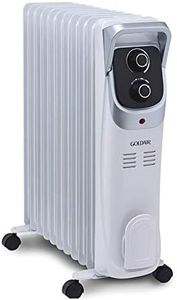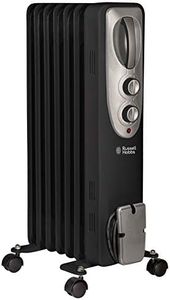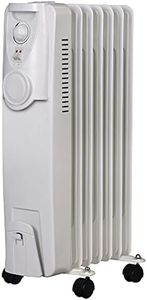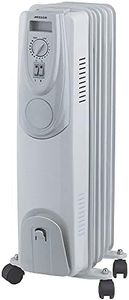We Use CookiesWe use cookies to enhance the security, performance,
functionality and for analytical and promotional activities. By continuing to browse this site you
are agreeing to our privacy policy
7 Best Oil Heaters
From leading brands and best sellers available on the web.Buying Guide for the Best Oil Heaters
Choosing the right oil heater can help you stay warm and comfortable during colder months. Oil heaters are popular because they provide even, consistent heat and are generally safe and easy to use. To pick the best oil heater for your needs, you should consider some key specs and think about where and how you’ll use the heater—like the size of your room, how quickly you want it to heat up, and any additional features that could make your life easier.Power (Wattage)Wattage measures how powerful the heater is and how much heat it can produce. A higher wattage means more heat output, which is suitable for larger rooms, while lower wattage is best for small spaces like bedrooms or offices. Usually, oil heaters range from about 700 to 2500 watts. For a small room, a heater with up to 1200 watts may be enough, but for medium to large rooms, look for something between 1500-2500 watts. Think about the size of the area you want to heat—the bigger the room, the more wattage you need.
Number of Fins or ColumnsFins or columns refer to the vertical segments in the heater that help transfer heat into the room. More fins generally mean a larger surface area, which can improve heat distribution and warmth. Smaller heaters might have 5-7 fins for compact spaces, while larger heaters could have 9, 11, or more fins for wide or open areas. Choose fewer fins if you have limited space and need quick warmth, or opt for more fins if you want to heat large rooms evenly over time.
Thermostat ControlsA built-in thermostat lets you set and maintain a specific temperature in the room. Some heaters offer simple dial controls with a few heat levels, while others have more precise digital or adjustable thermostats for better control. If you like steady temperatures or want to avoid overheating the room, look for a model with a thermostat. Consider your comfort: if you want to set it and forget it, prioritize this feature.
Timer SettingsTimer settings allow you to program the heater to turn on or off after a certain period. Mechanical timers usually have simple options for up to 24 hours, while digital timers offer more flexibility. This feature is useful if you want the heater to run only at certain times, like before you wake up or come home. Pick a heater with a timer if you want convenience or wish to save energy by not running it all day.
Portability FeaturesPortability includes features like wheels, carry handles, and overall weight, which make it easy to move the heater from room to room. Lighter heaters or those with smooth-rolling castors are better for moving frequently, while heavier models are good if you want to keep the heater in one place. Consider how often you'll move your heater—if mobility is important, look for helpful handles and good-quality wheels.
Safety FeaturesKey safety features include tip-over protection, overheat protection, and a cool-touch surface. Tip-over protection shuts the heater off if it falls, overheat protection stops it if it gets too hot, and cool-touch surfaces prevent accidental burns. These are important if you have children, pets, or just want extra peace of mind. Prioritize safety features according to your household needs.
Noise LevelNoise level refers to how quietly the heater operates. Oil heaters are generally very quiet because they use radiant rather than fan-based heating. If you need silence for sleeping or working, most oil heaters will suit you, but you can read user reviews to confirm. For bedrooms or offices, a quiet heater adds to your comfort.






